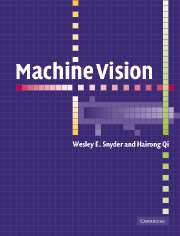Book contents
- Frontmatter
- Contents
- To the instructor
- Acknowledgements
- 1 Introduction
- 2 Review of mathematical principles
- 3 Writing programs to process images
- 4 Images: Formation and representation
- 5 Linear operators and kernels
- 6 Image relaxation: Restoration and feature extraction
- 7 Mathematical morphology
- 8 Segmentation
- 9 Shape
- 10 Consistent labeling
- 11 Parametric transforms
- 12 Graphs and graph-theoretic concepts
- 13 Image matching
- 14 Statistical pattern recognition
- 15 Clustering
- 16 Syntactic pattern recognition
- 17 Applications
- 18 Automatic target recognition
- Author index
- Index
4 - Images: Formation and representation
Published online by Cambridge University Press: 05 June 2012
- Frontmatter
- Contents
- To the instructor
- Acknowledgements
- 1 Introduction
- 2 Review of mathematical principles
- 3 Writing programs to process images
- 4 Images: Formation and representation
- 5 Linear operators and kernels
- 6 Image relaxation: Restoration and feature extraction
- 7 Mathematical morphology
- 8 Segmentation
- 9 Shape
- 10 Consistent labeling
- 11 Parametric transforms
- 12 Graphs and graph-theoretic concepts
- 13 Image matching
- 14 Statistical pattern recognition
- 15 Clustering
- 16 Syntactic pattern recognition
- 17 Applications
- 18 Automatic target recognition
- Author index
- Index
Summary
Computers are useless. They can only give us answers
Pablo PicassoIn this chapter, we describe how images are formed and how they are represented. Representations include both mathematical representations for the information contained in an image and for the ways in which images are stored and manipulated in a digital machine. In this chapter, we also introduce a way of thinking about images – as surfaces with varying height – which we will find to be a powerful way to describe both the properties of images as well as operations on those images.
Image representations
In this section, we discuss several ways to represent the information in an image. These representations include: iconic, functional, linear, probabilistic, spatial frequency, and relational representations.
Iconic representations (an image)
An iconic representation of the information in an image is an image. “Yeah, right; and a rose is a rose is a rose.” When you see what we mean by functional, linear, and relational representations, you will realize we need a word for a representation which is itself a picture. Some examples of iconic representations include the following.
2D brightness images, also called luminance images. The things you are used to calling “images.” These might be color or gray-scale. (Be careful with the words “black and white,” as that might be interpreted as “binary”). We usually denote the brightness at a point 〈x, y〉 as f(x, y). Note: x and y could be integers (in this case, we are referring to discrete points in a sampled image; these points are called “pixels,” short for “picture elements”), or real numbers (in this case, we are thinking of the image as a function).
[…]
- Type
- Chapter
- Information
- Machine Vision , pp. 38 - 64Publisher: Cambridge University PressPrint publication year: 2004



